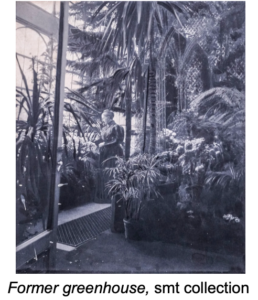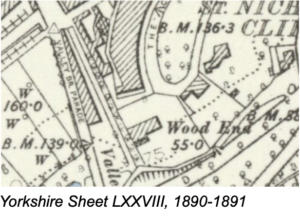Reflections from inside a greenhouse
Essay in response to exhibition by curator Martha Cattell

Former greenhouse, SMG collection
Reflections from inside a greenhouse
‘A glass building in which plants that need protection from cold weather are grown.’
dictionary definition
‘growing a garden is a beautiful radical act’
Blacklodge Press
I write this sat inside the former Woodend greenhouse, now a gallery the residue of its vegetal history still pervades with the faint line of past vines and ivy crawling up the stone walls and the large glass windows allowing light and warmth to permeate the space to an often uncomfortable temperature.
The trend for orangeries, greenhouses and conservatories began growing steadily in the 19th century, and were used to house plants from around the world, due to trade and colonisation, and glass was also becoming both cheaper and able to be purchased domestically in larger sizes. They became spaces to show off and exhibit species never before seen in the UK, and a way of interacting with the natural world but in a controlled and artificial way.
Recently discovered pictures of Woodend from the 19th century show how the space would have been inhabited with large palms, ferns and flowers of varying degrees, often stretching right up to the ceiling, the humid and dripping aura of which, would have often a rich contrast to the oaks, beeches and sycamore trees that would likely have been viewable out the window, a similar view to today. The map below shows Woodend in the 1890s with the crosshatching at the back of the building indicating the greenhouse, the small crossed lines of the map act as a mimic to the intricate trellising, which once stretched up the walls offering support and growing aid for the plants.


The greenhouse was transformed in the 21st century into a section of the Scarborough Natural History Museum, the faint lettering of which is present on the building offering a light trace of its past a space of wonder for visitors with a lot of fond memories retold on various social media forums and pages, reminiscing over the terrapins living in a central pond and a large mechanical fish that hung from the ceiling.
When thinking about archives, it is often the human and not the plant or animal that we remember, but these can often tell us important narratives around species change, social or cultural narratives of preservation, colonialism and display. With the exhibition ‘Dear Plants…’ we wanted to again bring the natural world in, but instead of using it as a space for entertainment and forced growth, we wanted to encourage new ways of interacting with and thinking with and not just of plants in creative and sensory ways. What does it look like to listen to a plant? What might a plant be thinking? How do we use plants in a sustainable way? How do we use the garden to enact social change?
This link between gardening and art is not new and there are numerous projects around the UK that are bridging this void, such as Grand Union’s The Growing Project and The Sheffield Wheat Experiment. These projects raise questions around the role of art within the climate, and the role of community, shared space, and shared greening. in his book, Climate A New Story, Charles Eisenstein states how ‘we need…people to do that, to listen closely to land, to develop a relationship with it’ and this is part of it, how can and should we use such spaces in the future, should we return them back to a growing space? How would that look? Who would care for it? It is this collectiveness and thinking beyond the galleries that are key in order to build collective care, institutions can’t just act as a passive host for climate related exhibitions without having policies or care for the environment they are trying to profile.
A garden does not just stop, it needs care, it needs time, so how do we do that? What are the next steps? Our communities are our garden, it is about nurturing, giving space in a mutual and understanding way. We are heading into a winter with a cost of living crisis, and live in a town where sewage and industrial waste is often found in the sea, and the council exclusively uses glyphosate as a herbicide, and where the local MP has spoken out against schemes such as rewilding, so there is change that needs to be made. In an ideal world we would expand onto the lawns, a landscape which artist/filmmaker Derek Jarman states in his book modern nature “Lawns, it seems to me, are against nature, barren and often threadbare – the enemy of a good garden. For the same trouble as mowing, you could have a year’s vegetables: runner beans, cauliflowers and cabbages, mixed with pinks and peonies, Shirley poppies and delphiniums; wouldn’t that beautify the land and save us from the garden terrorism that prevails?”
An alternative word for a greenhouse is a hothouse, the definition of which is an incubator space for ideas, and this is it, this exhibition does not offer a single solution to the climate crisis, but encourages small acts and community actions as a start, and creativity can and should play a key part in this. It is also up to creative institutions to care, it is no longer good enough to be passive observers, but we need to embrace the ‘humusities’ as Donna Haraway states and dissolve ourselves within the wider ‘compost pile of life.’
Written by Martha Cattell, (Crescent Arts Curator)
References and further reading
The Growing Project – Grand Union, https://grand-union.org.uk/projects/the-growing-project/
The Sheffield Wheat Experiment, https://www.thesheffieldwheatexperiment.co.uk
@Decolonisethegarden, Instagram, https://www.instagram.com/decolonisethegarden/?hl=en
Charles Eisenstein, Climate A New Story, (North Atlantic Books, 2008)
Donna J. Haraway, Staying with the Trouble (Experimental Futures): Making Kin in the Chthulucene, (Duke University Press Books, 2016)
Val Plumwood, Feminism and the Mastery of Nature, (Routledge, 1993)
Anna Tsing, The Mushroom at the End of the World, (Princeton University Press, 2015)
Join our mailing list
Stay up to date with our current and forthcoming programme, exhibition and events.
We don't share your information with anyone else.
